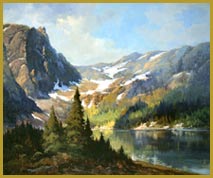|
|
|
|
Robert Wood and the Grandeur of Wyoming
by Jeffrey Morseburg
Robert Wood's paintings of the Grand Tetons were reproduced in a series of popular prints by the Donald Art Company in the 1950s. Wood traveled and painted extensively in Idaho and Wyoming in the 1940s, but he began to concentrate on the Tetons as a subject a number of years later.
Many of Wood's 1940s paintings focused on the rapids of the aptly-named Snake River, with mountain backdrops, but his later works were of the Teton Peaks, usually with the Snake River, String Lake or Jenny Lake in the foreground.
In his later Teton works, Robert Wood's technique was bolder, with more impasto, and he emphasized the rugged cragginess of the 13,77o' Grand Teton or 12,605' Mt. Moran, which was named for the great landscape painter and became a sentimental subject for Wood. In his larger Teton works Wood emphasized the grandiosity of the mountains, working in larger sizes to give the subject a truly panoramic treatment. These were usually 24" x 36", but he also produced paintings that were 24" x 48", 24" x 60" and 30" x 60". The
Teton range is a segment of the northern Rockies which runs southward
across northwestern Wyoming, beginning at the southern boundary
of Yellowstone National Park and ending at Teton Pass. The majestic
peaks can be seen from far into Eastern Idaho, and the foothills
extend into the potato state. The Teton range is forty miles long
and is dominated by the Grand Teton, which reaches 13,766 feet,
looming 7000 feet above Jackson Hole.
Copyright
2003 Jeffrey Morseburg. Not to be reproduced without specific written
permission. |
|



